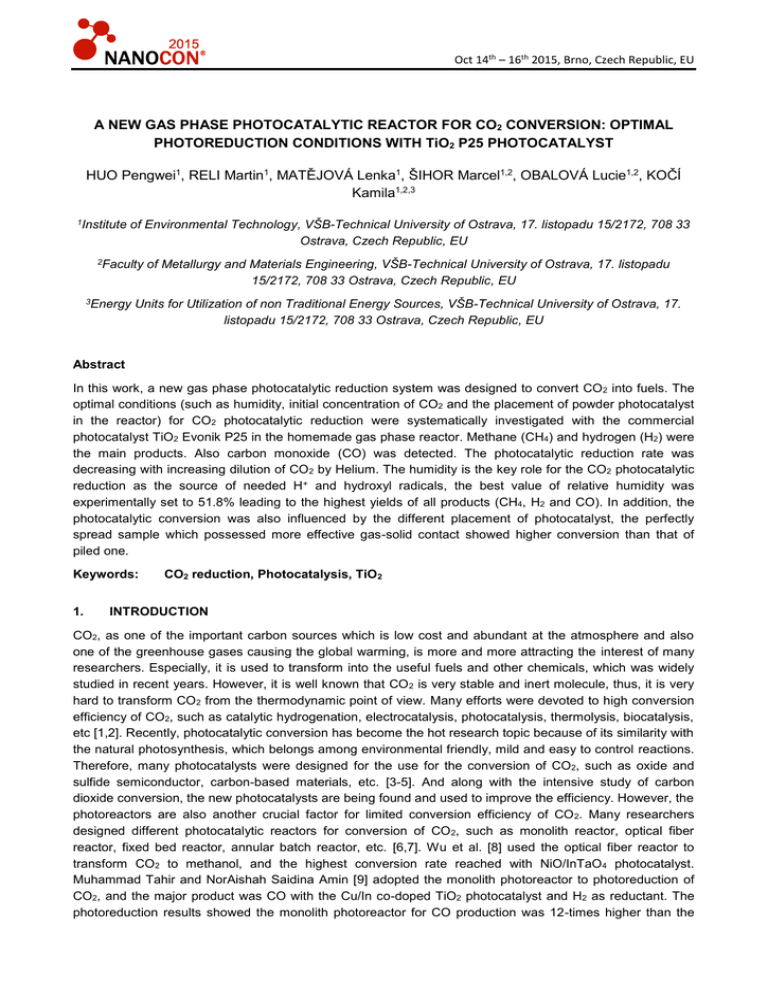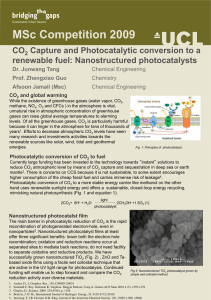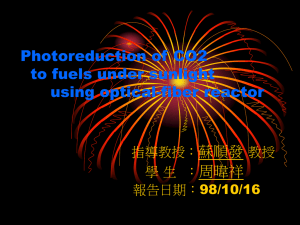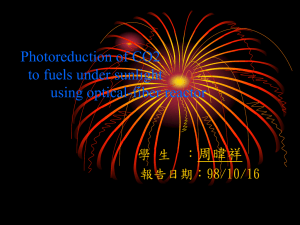A New Gas Phase Photocatalytic Reactor for Co2 Conversion
advertisement

Oct 14th – 16th 2015, Brno, Czech Republic, EU A NEW GAS PHASE PHOTOCATALYTIC REACTOR FOR CO2 CONVERSION: OPTIMAL PHOTOREDUCTION CONDITIONS WITH TiO2 P25 PHOTOCATALYST HUO Pengwei1, RELI Martin1, MATĚJOVÁ Lenka1, ŠIHOR Marcel1,2, OBALOVÁ Lucie1,2, KOČÍ Kamila1,2,3 1Institute of Environmental Technology, VŠB-Technical University of Ostrava, 17. listopadu 15/2172, 708 33 Ostrava, Czech Republic, EU 2Faculty 3Energy of Metallurgy and Materials Engineering, VŠB-Technical University of Ostrava, 17. listopadu 15/2172, 708 33 Ostrava, Czech Republic, EU Units for Utilization of non Traditional Energy Sources, VŠB-Technical University of Ostrava, 17. listopadu 15/2172, 708 33 Ostrava, Czech Republic, EU Abstract In this work, a new gas phase photocatalytic reduction system was designed to convert CO 2 into fuels. The optimal conditions (such as humidity, initial concentration of CO2 and the placement of powder photocatalyst in the reactor) for CO2 photocatalytic reduction were systematically investigated with the commercial photocatalyst TiO2 Evonik P25 in the homemade gas phase reactor. Methane (CH4) and hydrogen (H2) were the main products. Also carbon monoxide (CO) was detected. The photocatalytic reduction rate was decreasing with increasing dilution of CO2 by Helium. The humidity is the key role for the CO2 photocatalytic reduction as the source of needed H+ and hydroxyl radicals, the best value of relative humidity was experimentally set to 51.8% leading to the highest yields of all products (CH4, H2 and CO). In addition, the photocatalytic conversion was also influenced by the different placement of photocatalyst, the perfectly spread sample which possessed more effective gas-solid contact showed higher conversion than that of piled one. Keywords: 1. CO2 reduction, Photocatalysis, TiO2 INTRODUCTION CO2, as one of the important carbon sources which is low cost and abundant at the atmosphere and also one of the greenhouse gases causing the global warming, is more and more attracting the interest of many researchers. Especially, it is used to transform into the useful fuels and other chemicals, which was widely studied in recent years. However, it is well known that CO 2 is very stable and inert molecule, thus, it is very hard to transform CO2 from the thermodynamic point of view. Many efforts were devoted to high conversion efficiency of CO2, such as catalytic hydrogenation, electrocatalysis, photocatalysis, thermolysis, biocatalysis, etc [1,2]. Recently, photocatalytic conversion has become the hot research topic because of its similarity with the natural photosynthesis, which belongs among environmental friendly, mild and easy to control reactions. Therefore, many photocatalysts were designed for the use for the conversion of CO2, such as oxide and sulfide semiconductor, carbon-based materials, etc. [3-5]. And along with the intensive study of carbon dioxide conversion, the new photocatalysts are being found and used to improve the efficiency. However, the photoreactors are also another crucial factor for limited conversion efficiency of CO 2. Many researchers designed different photocatalytic reactors for conversion of CO 2, such as monolith reactor, optical fiber reactor, fixed bed reactor, annular batch reactor, etc. [6,7]. Wu et al. [8] used the optical fiber reactor to transform CO2 to methanol, and the highest conversion rate reached with NiO/InTaO4 photocatalyst. Muhammad Tahir and NorAishah Saidina Amin [9] adopted the monolith photoreactor to photoreduction of CO2, and the major product was CO with the Cu/In co-doped TiO2 photocatalyst and H2 as reductant. The photoreduction results showed the monolith photoreactor for CO production was 12-times higher than the Oct 14th – 16th 2015, Brno, Czech Republic, EU cell-type photoreactor. Yuan et al. [10] transformed CO2 into fuels using the optical fiber monolith reactor; the new reactor effectively improved the conversion of CO2 to methanol. Cheng et al. [11] built a novel twin reactor and used it for conversion of CO 2 to CH3OH with mixture of CO and CO2 as the feed, the result showed remarkably increased conversion of carbon dioxide. Our group designed various stirred batch annular reactors, which were used for photocatalytic reduction of CO 2 towards possible fuels such as CH4, CO, CH3OH, etc. [12-16]. Although there were many investigations focused on CO2 conversion with different photocatalysts, most of the reactors contain both liquid and gas phase, or only liquid, or gas with sacrificial agent. In this work, we designed a pure gas phase photocatalytic reactor for CO2 conversion to fuels, and the optimal conditions for the CO2 conversion were investigated in the presence of commercial catalyst TiO2 P25 which is considered as the standard photocatalyst and it is also well known photocatalyst for degradation of pollutants. 2. EXPERIMENTAL 2.1. Materials TiO2 P25 was purchased from Sigma-Aldrich (Prague, Czech Republic); A supercritical fluid-grade CO2 was obtained from SIAD Technical Gases, CZ. 2.2. Photocatalytic reduction of CO2 The scheme of the photocatalytic reduction system is depicted on Fig.1, and it mainly contains five parts:(1) the mass flow controller; (2) humidity adjustment; (3)photoreactor; (4)GC analysis; (5)pressure test. The photocatalytic reduction processes of CO 2 can be described as follows: first, the flow of CO 2 gas and/or carrier gas (such as He) was controlled by the Sierra mass flow controllers which allows us to obtain different concentration of CO2 in the reactor; second the CO2 or the mixed gas is being saturated by water vapor by passing through the deionized water which could adjust the humidity of the gas in the reactor; 100 mg of TiO2 P25 was spread on the glass at the bottom of reactor, the outlet valve of reactor was adjusted to control the gas flow so all the air was removed from the reactor; after 20 minutes the reactor was sealed and pressurized to above 1.3 atm. The photocatalytic reduction of CO2 started by turning on the UV lamp and the reaction time was 24 hours. Gas samples were discontinuously taken and immediately analyzed on GC/BID. Among the detected products was CH4, H2 and CO. Fig. 1 The schematic description of gas phase photocatalytic reduction of CO2. Oct 14th – 16th 2015, Brno, Czech Republic, EU 3. RESULTS AND DISCUSSION 3.1. Characterization of TiO2 photocatalyst According to information from producer, specific surface area of TiO2 Evonik P25 photocatalyst was 50 m2 g 1, band gap energy was 3.38 eV, sample contained 80 wt.% anatase and 20 wt.% rutile with crystallite size of 25 and 54 nm, respectively. 3.2. The influence of different concentration of CO2 on photocatalytic reduction The production of one reaction is greatly limited by the initial concentration of reactant, thus the influence of different initial concentration of CO2 (different concentration of CO2 was obtained by diluting by helium) on products yields was investigated, the results are showed in Fig.2. According to the results, it can be clearly found that the yield of H2 is the higher than those of CH4 and CO in every photocatalytic reduction process. Also it possesses highest yield of all products (CH 4, H2 and CO) at 100% initial concentration of CO 2 in the gas phase reactor. The results are in agreement with the report from Lo et al. [17] who investigated photocatalytic reduction different concentration of CO 2 (diluted with N2) with acidic photocatalyst (TiO2/SO42−), and the yields of CO and CH4 were enhanced with increasing the initial concentration of CO 2, but the H2 was used as reductant in this photocatalytic reduction process. Moreover, it can be seen that the yield of CH4 is also high when the initial concentration of CO2 is around 31% or 20%, but the H2 is much lower compared to initial concentration 100% of CO2. This result is corresponding with the work published by Akhter et al. who has chosen the concentration 20% of CO 2 as initial concentration for the reaction [18]. Based on experimental data pure carbon dioxide was used for further experiments. Product yields (mmol/gcat) 100 3.3. 80 CH4 H2 60 CO 40 20 0 Fig.2 The influence of100 different62 CO2 concentration 41 37 on photocatalytic 31 25 reduction. 22 20 CO2 concentration (%) The influence of different humidity on the photocatalytic reduction of CO 2 It is well known that the CO2 can be transformed into the organic compounds and O2 molecules via the natural photosynthesis. Therefore the artificial photocatalytic reduction CO2 must meet the similar requirements and only after that CO2 can be transformed into the so much desired fuels. Especially, the humidity, which offers the necessary reductant, is seriously important for the conversion of CO 2 under the light irradiation, thus the influence of different humidity in the reactor for CO 2 conversion was investigated. The results are shown in Fig.3. It can be clearly found that the conversion rate of CO2 was critically limited by Oct 14th – 16th 2015, Brno, Czech Republic, EU the humidity. Apparently, the order of all the products yield (H 2, CH4 and CO) is decreasing in order of humidity as follows ~51.8% > ~69.7% > ~29.2%. The reason may be due to that the low humidity possesses small amount of H2O molecules which could not offer enough reductant for photocatalytic reduction of CO 2; the high humidity contains more H2O molecule, but the H2O molecule is the polar molecule which could be adsorbed on the surface of TiO2 and inhibit the proceeding of photocatalytic reduction CO 2, thus the CO2 conversion efficiency was decreased at high humidity. Specially, the conversion of CO2 with the humidity at 51.8% is obviously higher than that of ~69.7% and ~29.2%, indicating that the humidity around ~51.8% is the best one for the CO2 conversion in our home-made photocatalytic reduction reactor. The results are well in agreement with the paper published by Rani et al. They have tested various amounts of relative humidity ranging from 0 to 100% for the photocatalytic reduction of carbon dioxide with co-catalyst (Cu, Pt) sensitized TiO2. The highest yields of both products, methane and hydrogen, were obtained in the presence of 55% of relative humidity [19]. Product yields (mmol/gcat) 100 CH4 80 H2 CO 60 40 20 0 Fig.3 The influence of different reduction of CO 2. 29.2humidity for photocatalytic 51.8 69.7 3.4. Humidity (%) The influence of TiO2 P25 placement on photocatalytic reduction of CO2 The catalytic efficiency of gas-solid phase reaction is mainly relied on the gas-solid contact [20], which mean the shape and/or placement of catalysts is important to gas-solid reaction under the same conditions, the effective gas-solid contact could possess better adsorption of reactant. Actually, the different shapes and/or placement of the catalysts could obtain different surface properties (such as surface area, different surface groups, etc.) which limited the surface reaction sites of catalysts for gas-solid phase reaction, thus the effective gas-solid contact can offer more reaction sites and the catalytic rate will be enhanced. In terms of this reason, the different placements of P25 for photocatalytic reaction of CO2 were investigated. The results are shown in Fig.4. Fig.4 (a and b) shows that P25 was dispersed and piled onto the glass, respectively. It was experimentally confirmed that the products yield in the presence of dispersed P25 were higher than in presence of the piled P25 under the same conditions. The reason could be attributed to more effective gassolid contact of the dispersed sample between CO2 and P25, therefore there were more active, easily reached reaction sites and also higher photons absorption. Therefore the yields of CH4, H2 and CO were 11.0 μmol/gcat., 100.9 μmol/gcat. and 2.5 μmol/gcat. after 24 h of irradiation, respectively. And the yields in the presence of piled sample were lower because the piled P25 photocatalysts possesses smaller gas-solid contact between CO2 and P25 and of course lower ability to absorb photons, resulting in lower amount of active sites available for the photocatalytic reduction process itself. Even though specific surface area is not the most decisive property for the rate of photocatalytic reduction of CO 2 if two different photocatalysts are Oct 14th – 16th 2015, Brno, Czech Republic, EU being compared, but in case of the same material higher specific surface area leads toward higher reaction rate. This was for example confirmed by, Zhang et al. who reported various nanoporous polymer monolithsupported Degussa P25 photocatalysts with different specific surface area and compared to powder P25. All the photocatalysts were tested for the photocatalytic degradation of Rhodamine B and the results confirmed that the reaction rate is increasing with increasing specific surface area [21]. 120 100 Products yield(¦Ìmol/gcat.) Product yields (¦Ìmol/gcat.) CH4 100 H2 CO 80 (b) (a) 60 40 20 CH4 80 H2 CO 60 40 20 0 0 0 5 10 15 Time (h) 20 25 0 5 10 15 20 25 Time (h) Fig.4 The influence of different P25 placements for conversion CO 2 4. CONCLUSION In summary, we successfully built a gas phase reactor for the photocatalytic reduction of CO 2. The influencing factors were investigated in order to find optimal reaction conditions. It was found out the photocatalytic reduction rate was decreasing with increasing dilution of CO2 by Helium. Also the humidity strongly influences the CO2 photocatalytic reduction. Based on the experimental data the best value of humidity was set to 51.8% which exhibited highest conversion rate under the same conditions. In addition, different placements of photocatalyst and its influence on the photocatalytic reduction of CO 2 was investigated. The highly dispersed sample showed much higher conversion rate than the piled one. Finding the optimal conditions for a new reactor is a beginning for further work focused on better understanding the reaction mechanism of the photocatalytic reduction of carbon dioxide. ACKNOWLEDGEMENTS The financial support of the Grant Agency of the Czech Republic (projects No. 14-23274S and 14-35327J), “National Feasibility Program I”, project LO1208 “TEWEP” from Ministry of Education, Youth and Sports of the Czech Republic and SP2015/125 are acknowledged. REFERENCES [1] LI K., AN X., PARK K. H., KHRAISHEH M., TANG J. A critical review of CO2 photoconversion: catalysts and reactors, Catalsis Today, Vol.224, 2014, pp. 3-12. [2] DAS S., DAUD W.M.A.W. Photocatalytic CO2 transformation into fuel: A review on advances in photocatalyst and photoreactor, Renewable and Sustainable Energy Reviews, Vol.39, 2014, pp. 765-805. [3] LI X., LIU H.L., LUO D.L., LI J.T., HUANG Y., Huiling Li, FANG Y.P., XU Y.H., ZHU L. Adsorption of CO2 on heterostructure CdS(Bi2S3)/TiO2 nanotube photocatalysts and their photocatalytic activities in the reduction of CO2 to methanol under visible light irradiation. Chemical Engineering Journal, Vol. 180, 2012, pp. 151-158. [4] ASI M. A., ZHU L.F., HE C., SHARMA V. K., SHU D., LI S.Z., YANG J.N., XIONG Y. Visible-light-harvesting reduction of CO2 to chemical fuels with plasmonic Ag@AgBr/CNT nanocomposites. Catalysis Today, Vol.216, 2013, pp. 268-275. Oct 14th – 16th 2015, Brno, Czech Republic, EU [5] YUAN L., XU Y. J. Photocatalytic conversion of CO2 into value-added and renewable fuels. Applied Surface Science, Vol. 342, 2015, pp. 154-167. [6] TAHIR M., AMIN N. S. Advances in visible light responsive titanium oxide-based photocatalysts for CO2 conversion to hydrocarbon fuels. Energy Conversion and Management, Vol. 76, 2013, pp. 194-214. [7] OLA O., MAROTO-VALER M. M. Review of material design and reactor engineering on TiO2 photocatalysis for CO2 reduction. Journal of Photochemistry and Photobiology C: Photochemistry Reviews, Vol. 24, 2015,pp. 16–42. [8] WANG Z. Y., CHOU H.C., WU J.C.S., TSAI D.P., MUL G., CO2 photoreduction using NiO/InTaO4 in optical-fiber reactor for renewable energy. Applied Catalysis A: General, Vol. 380, No.1-2, 2010, pp. 172-177. [9] TAHIR M., AMIN N. A. S. Photocatalytic CO2 reduction with H2 as reductant over copper and indium co-doped TiO2 nanocatalysts in a monolith photoreactor. Applied Catalysis A: General, Vol. 493, 2015, pp. 90-102. [10] YUAN K., YANG L., DU X., YANG Y. Performance analysis of photocatalytic CO2 reduction in optical fiber monolith reactor with multiple inverse lights. Energy Conversion and Management, Vol. 81, 2014, pp. 98-105. [11] CHENG Y.H., NGUYEN V. H., CHAN H.Y., WU J.C.S., WANG W.H. Photo-enhanced hydrogenation of CO2 to mimic photosynthesis by CO co-feed in a novel twin reactor. Applied Energy, Vol. 147, 2015, pp. 318-324. [12] KREJČÍKOVÁ S., MATĚJOVÁ L., KOČÍ K., OBALOVÁ L., MATĚJC Z., ČAPEKD L., ŠOLCOVÁ O. Preparation and characterization of Ag-doped crystalline titania for photocatalysis applications. Applied Catalysis B: Environmental, Vol. 111-112, 2012, pp. 119-125. [13] MATĚJOVÁ L., KOČÍ K., RELI M., ČAPEK L., HOSPODKOVÁ A., PEIKERTOVÁ P., MATĚJC Z, OBALOVÁ L., WACH A., KUŚTROWSKI P., KOTARBA A. Preparation, characterization and photocatalytic properties of cerium doped TiO2: On the effect of Ce loading on the photocatalytic reduction of carbon dioxide. Applied Catalysis B: Environmental, Vol. 152-153, 2014, pp. 172-183. [14] KOČÍ K., MATĚJOVÁ L.,KOZÁK O., ČAPEK L., VALEŠ V., RELI M., PRAUS P., ŠAFÁŘOVÁ K., KOTARBA A., OBALOVÁ L. ZnS/MMT nanocomposites: The effect of ZnS loading in MMT on the photocatalytic reduction of carbon dioxide. Applied Catalysis B: Environmental, Vol. 158-159, 2014, pp.410-417. [15] KOČÍ K., MATĚJŮ K., OBALOVÁ L., KREJČÍKOVÁÁS., LACNÝÝA Z., PLACHÁ D., ČAPEK L., HOSPODKOVÁÁA., ŠOLCOVÁ O. Effect of silver doping on the TiO2 for photocatalytic reduction of CO2. Applied Catalysis B: Environmental, Vol. 96, 2010, pp.239-244. [16] KOČÍ K., OBALOVÁ L., MATĚJOVÁ L., PLACHÁÁD., LACNÝÝA Z., JIRKOVSKÝ J., ŠOLCOVÁ O. Effect of TiO2 particle size on the photocatalytic reduction of CO2. Applied Catalysis B: Environmental, Vol. 89, 2009, pp. 494502. [17] LO C. C., HUNG C.H., YUAN C.S., HUNG Y.L. Parameter Effects and Reaction Pathways of Photoreduction of – CO2 over TiO2/SO42 Photocatalyst. Chinese Journal of Catalysis, Vol.28, No.6, 2007, pp. 528-534. [18] AKHTER P., HUSSAIN M., SARACCO G., RUSSO N. Novel nanostructured-TiO2 materials for the photocatalytic reduction of CO2 greenhouse gas to hydrocarbons and syngas. Fuel, Vol. 149, 2015, pp. 55-65. [19] RANI S., BAO N.Z., ROY S.C. Solar Spectrum Photocatalytic conversion of CO2 and water vapor into hydrocarbons using TiO2 nanoparticle membranes. Applied Surface Science, Vol.289, 2014, pp.203-208. [20] YAN W.C. Handbook of Fluidization and Fluid-Particle Systems. Taylor & Francis Group LLC: New York, 2003. [21] ZHANG Y.L., WEI S., ZHANG H.Y., LIU S., NAWAZ F., XIAO F.S. Nanoporous polymer monoliths as adsorptive supports for robust photocatalyst of Degussa P25. Journal of Colloid and Interface Science, Vol. 339, No.2, 2009, pp.434-438.







